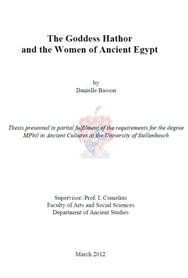
In studying ancient Egypt researchers have a great advantage, in that there is a multitude of recorded material to draw from. Unfortunately for anyone interested in studying ancient Egyptian women, the recorded material was most often recorded by, commissioned by, and concerned with, men; royal or high-ranking men to be precise (Robins, 1993: 11-12). Thus, we must look into non-textual artefacts and offerings which may have a symbolic meaning. Though, the textual sources should not be neglected, since these may hold clues to the position and perception of women in society: perceptions held by men. This thesis has drawn largely on art and artefacts to investigate the relationship between women in ancient Egypt and the goddess Hathor. Women are traditionally the mothers, caretakers and homemakers of society. But they are not only that. Women are also individuals, capable of individual thought, feelings, anxieties, hopes and dreams; and like their male counterparts, women also experience religion. But, as was clearly displayed in the thesis, Egyptian women not only experienced religion, they lived religion. In the ancient Egyptian context there was no escaping religion. It must also be understood that the ancient Egyptians thought that the man was the seat of creation and that semen was the essence of creation (according to the cosmogony of Heliopolis, cf. Cooney, 2008: 2). A failure to conceive would be placed directly upon the shoulders of the woman, and could be grounds enough for divorce (Robins, 1993: 63). Women in ancient societies served the main function of child-rearing. This may seem backward, but it was an essential function, without which society would cease to function. When a woman failed to conceive, she in essence failed her function as a woman; many women (and men) in this situation turned to religion. This is where this thesis topic comes into play, since Hathor was a goddess of sexuality and fertility, but also had aspects of safeguarding and caretaking. Women were naturally drawn to her and she developed a large cult following, with cult centres scattered throughout Egypt. Not only were many of her followers female, but her priests were also female (Gillam, 1995: 211-212). Hathor might have been the most relatable of the goddesses because of her dual-nature; she is a caretaker and sexual being, but she can also become fierce and even bloodthirsty. Devotion to Hathor was widespread, with cult centres at Deir el-Bahari, Faras, Mirgissa, Serabit el-Khadim, Timna, Gebel Zeit and elsewhere, each with its own large deposit of votive offerings (Pinch, 1993). Hathor is also referenced in letters between females in a family, as one daughter writes to her mother: “May Hathor gladden you for my sake” (Wente, 1990: 63). It is because of this that this thesis investigated to what an extent ancient Egyptian women had a relationship with her.

